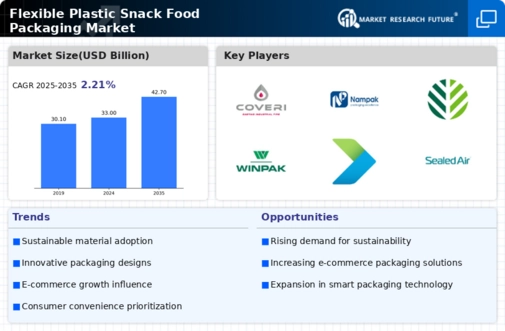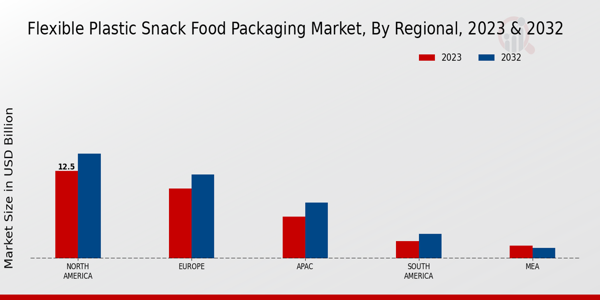Market Growth Projections
The Global Flexible Plastic Snack Food Packaging Market Industry is poised for substantial growth, with projections indicating a market value of 33.0 USD Billion in 2024 and an anticipated increase to 42.7 USD Billion by 2035. This growth trajectory suggests a compound annual growth rate (CAGR) of 2.38% from 2025 to 2035. Such figures underscore the industry's resilience and adaptability in meeting evolving consumer demands and preferences. The ongoing innovations in packaging technologies and materials are likely to play a pivotal role in sustaining this growth, positioning the industry favorably for future developments.
Sustainability Initiatives
Sustainability emerges as a pivotal driver within the Global Flexible Plastic Snack Food Packaging Market Industry. As environmental concerns gain prominence, manufacturers are increasingly adopting eco-friendly materials and practices. The shift towards biodegradable and recyclable packaging solutions aligns with consumer preferences for sustainable products. This transition not only meets regulatory requirements but also enhances brand loyalty among environmentally conscious consumers. The market is expected to evolve significantly, with projections indicating a growth trajectory that could see it reach 42.7 USD Billion by 2035. This commitment to sustainability is likely to reshape packaging strategies across the industry.
Rising Demand for Convenience Foods
The Global Flexible Plastic Snack Food Packaging Market Industry experiences a notable surge in demand for convenience foods. As lifestyles become increasingly fast-paced, consumers gravitate towards ready-to-eat snacks that offer portability and ease of consumption. This trend is reflected in the projected market value, anticipated to reach 33.0 USD Billion in 2024. Flexible plastic packaging provides an ideal solution, allowing manufacturers to create lightweight, resealable, and easy-to-open packages that enhance user experience. Consequently, the growth in convenience food consumption directly influences the expansion of the flexible plastic packaging sector.
Globalization and Cross-Border Trade
Globalization facilitates the expansion of the Global Flexible Plastic Snack Food Packaging Market Industry across borders. As international trade increases, snack manufacturers seek packaging solutions that comply with diverse regulatory standards and consumer preferences in various regions. Flexible plastic packaging offers versatility, allowing products to be tailored for different markets while ensuring compliance with local regulations. This adaptability is crucial for companies aiming to penetrate new markets and enhance their global footprint. The ongoing trend of globalization is expected to bolster the demand for flexible packaging solutions, further driving market growth.
Growth of E-commerce and Online Retail
The rise of e-commerce and online retail significantly impacts the Global Flexible Plastic Snack Food Packaging Market Industry. With the increasing preference for online shopping, snack manufacturers are adapting their packaging to cater to the demands of e-commerce logistics. Flexible plastic packaging offers advantages such as reduced weight and space efficiency, making it ideal for shipping. As more consumers turn to online platforms for their snack purchases, the need for packaging that withstands transportation while maintaining product integrity becomes paramount. This shift is likely to drive further innovation and investment in flexible packaging solutions.
Technological Advancements in Packaging
Technological advancements play a crucial role in shaping the Global Flexible Plastic Snack Food Packaging Market Industry. Innovations in materials science and packaging technologies enable the development of more efficient and effective packaging solutions. For instance, advancements in barrier technologies enhance the shelf life of snacks, reducing food waste and improving product quality. Moreover, smart packaging solutions, such as QR codes and temperature indicators, provide consumers with valuable information about product freshness. These innovations are likely to contribute to a compound annual growth rate (CAGR) of 2.38% from 2025 to 2035, reflecting the industry's adaptability to evolving consumer needs.
























Leave a Comment